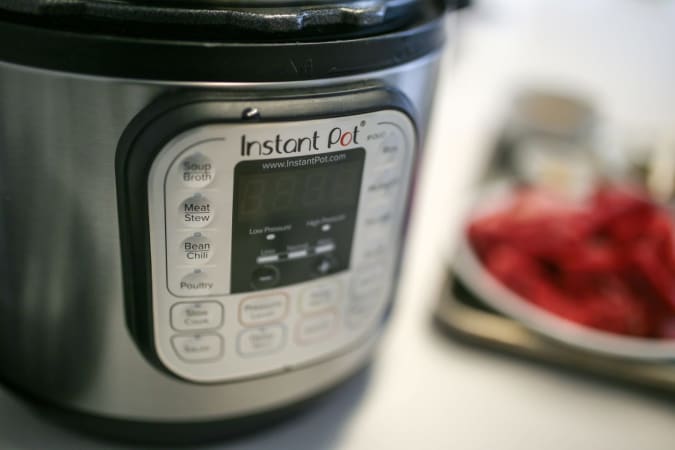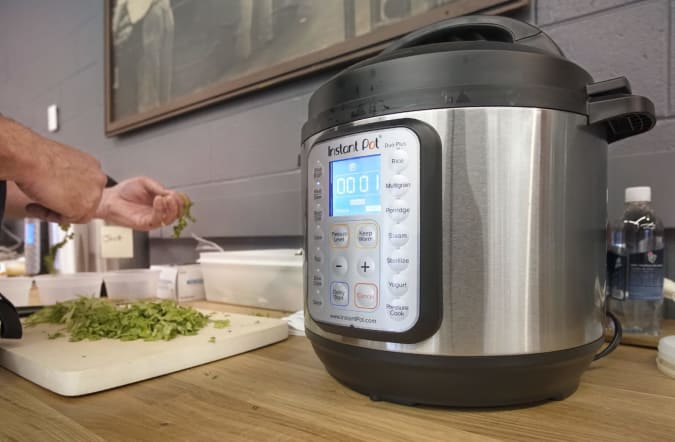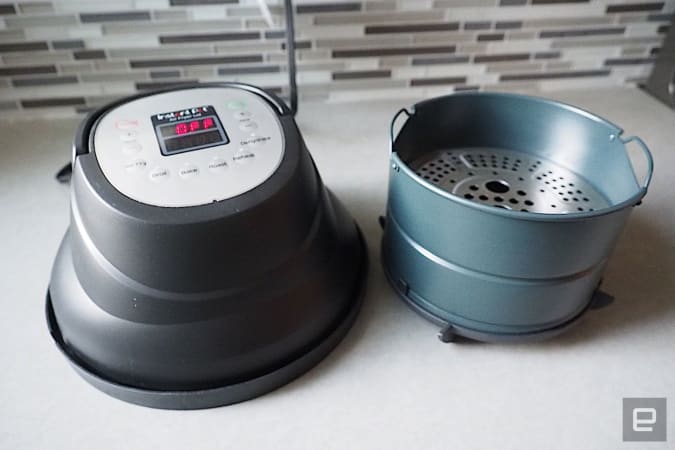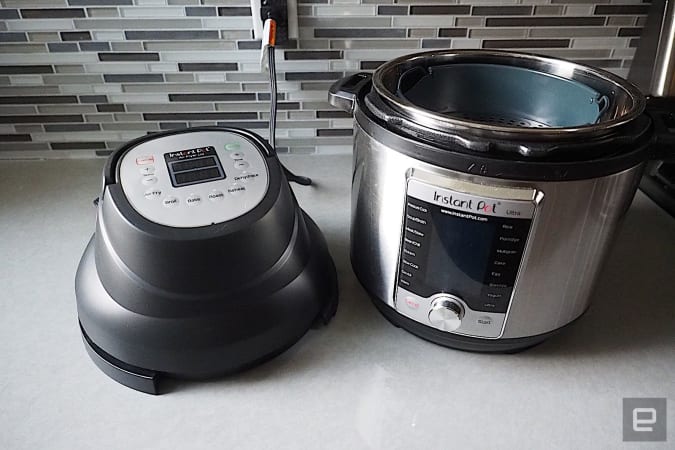All products recommended by Engadget are selected by our editorial team, independent of our parent company. Some of our stories include affiliate links. If you buy something through one of these links, we may earn an affiliate commission.
Few kitchen appliances have reached the same cult status as the Instant Pot. With 1.9 million members on the official Instant Pot Facebook group, more than 100 fan-created online groups, around 30,000 reviews on Amazon and accolades from the likes of The New York Times, it’s no question that this kitchen marvel is a hit.
It’s a winner with the Engadget staff, too; not only have a few of us bought it for ourselves, we’ve recommended it in past gift guides. Sure, it’s not a tech gadget per se (although there is a “smart” edition with an app and Google Assistant), but it does have a lot of crossover appeal thanks to its promise of all-in-one efficiency.
But what do you do when you get one? With so many recipes on the internet and so many different things you can do with it, where do you even start? In this guide, I’ll attempt to give you a primer on the first steps you should take when you get one, some tips and tricks on how to use it and a few favorite recipes and source links. A lot of this comes from personal experience; I’ve been an Instant Pot owner for a few years. I’ll also note that the listed recipes lean toward my own taste, but hopefully this guide will provide a good start for your own culinary adventures.
How Instant Pots work

If you’re reading this, you probably already know what an Instant Pot is, but just in case you don’t, here’s a brief introduction. The Instant Pot is an “all-in-one” kitchen gadget that promises to replace a rice cooker, a yogurt maker and a slow cooker; it also lets you sauté and steam foods. But the real reason the Instant Pot has risen to fame is that it’s also a very good electric pressure cooker. This lets you cook food at an accelerated rate; imagine pulled pork in an hour instead of five or a chicken curry done in 10 minutes. And because it’s electric, you just press a few buttons and walk away. Unlike a stovetop pressure cooker, there’s no need to keep a constant eye on it.
There are a bunch of Instant Pot models to choose from. Some of the lower-end ones lack the yogurt-maker, and a couple of the higher-end models have extra features like sous-vide cooking and canning, but all have the electric pressure cooker function, so much of this guide will focus on that. The Instant Pot comes in 3-, 6- and 8-quart sizes. Unless you’re only cooking for yourself or you have a large family, I think the 6-quart model should work for most people.
Buy Instant Pot Duo at Amazon – $89
A brief word on other Instant Pot models:
-
The Duo Plus (starting at $100) is an upgraded version of the Duo Series. It has two additional functions: sous vide (for temperature-controlled cooking) and sterilizer (a steam shortcut for sterilizing items like baby bottles). There’s also a cooking progress status bar plus an anti-spin design that keeps the inner pot in place when you’re sauteing.
-
The Pro (starting at $115) is designed for the serious cooking enthusiast, with plenty of upgrades over existing Instant Pots. The inner pot has an extra thick bottom that can go on the stove, plus it has handles so it’s easier to lift. It comes with 28 customizable programs for different foods, and there are five favorites buttons that you can assign to frequently cooked meals. The steam release switch has been upgraded to reduce noise and splatter, and there are even steam release reminder alerts with 5- and 10-minute pre-sets. The Pro is also one of a few Instant Pots compatible with an optional QuickCool lid that helps you release pressure faster.
-
The Duo Crisp + Air Fryer ($180) is basically an Instant Pot that comes with an additional Air Fryer Lid, which adds dry-heat cooking methods like baking, broiling, dehydrating and of course air-frying. There’s also a Pro version of this Instant Pot ($200) that pairs the air fryer lid with the Pro model mentioned above.
-
The Star Wars Instant Pots ($100) are a great choice for the Star Wars enthusiast or just anyone who wants a fun and unique kitchen appliance. They’re really just rebranded versions of the Duo, with the same exact functionalities and features. They come in five iterations: Little Bounty, Darth Vader, Stormtrooper, BB-8, and R2-D2.
Which Instant Pot model is right for you?
-
The 6-quart Instant Pot is ideal for most people, but if you’re a singleton or a student, then the 3-quart model is best. For large families, or simply those who like to make a lot of food, then the 8-quart model is a good choice.
-
If you’re interested in diving into sous vide but don’t want to make an investment in a separate machine just for that, then the Instant Pot Smart WiFi, Ultra, Duo Crisp or the Duo Plus are good choices.
-
If you’re really into pressure-canning and preserving foods, then the Instant Pot Max is the one for you. It’s the only one that’s capable of reaching 15 PSI, which is needed for pressure-canning.
-
Making yogurt with the Instant Pot is really easy because it can maintain the same temperature for hours. Models that have this feature include the Duo, Duo Nova, Smart WiFi, Ultra and Duo Plus.
Getting started
With any appliance, I would suggest reading the instructions to get a full idea of how to use it, but here’s a brief primer.
The Instant Pot has three parts: the housing with the cooking element at the bottom; the stainless steel inner pot; and the lid, which comes with a sealing ring plus a steam-release valve. Setup is as easy as putting the inner pot inside the housing and plugging it in. You’ll also want to attach a tiny condensation collector on the back if the instructions call for it.

The first thing to do is a “water test,” which not only helps familiarize you with the basic pressure-cooker features but will confirm your appliance is in proper working order.
To do a water test, put three cups of water in the pot, twist the lid on — it’ll make a sound when it’s locked in place — and set the pressure cooker on high for two minutes. The way to do this varies from model to model; on the Duo machines, you’ll have to press Manual, select High, then dial down the time to two minutes. On something like the Ultra, you just need to go to the Pressure Cooker menu, dial it to two minutes and select High.
Then make sure your valve is set to “Sealing” so that the Instant Pot can build pressure. On the Duo machines, this means rotating it so the arrow points up, while on the Ultra, the valve will automatically be set to Sealing.
Then press “Start.” From there, the Instant Pot will build up that pressure to High, maintain it for the set two minutes, and then stop. In some cases, you’ll hear hissing and see steam coming out of the Instant Pot. This is totally normal. You’ll know the Instant Pot is under pressure when the float valve pops up and the hissing quiets down.
The lid cannot be opened when the Instant Pot is under pressure. You must depressurize it first. Once the cooking is done, you can let the pot naturally depressurize (also known as “Natural Release”), which simply means leaving it alone for 20 or so minutes until the float valve comes down.
Or you can do a manual release (also known as “Quick Release”) by switching that aforementioned valve to “Venting.” To do that on the Duo models, you rotate the valve, while on the Ultra, you’ll press a steam release button on the top. This method will release a lot of steam, so I suggest doing this under a range hood if you have one. Again, once the float valve comes back down, you’ll know the Instant Pot has been depressurized.
Doing the water test teaches you the basics of sealing the Instant Pot, setting it and depressurizing it. Plus, if anything goes wrong along the way — especially if it doesn’t seal the pressure — you can call the retailer or manufacturer to troubleshoot or ask about a return or exchange. It’s a step that many people skip, but I recommend it, especially if you’re a beginner.
Instant Pot accessories

The Instant Pot is ready to use right out of the box, but if you want to get even more functionality out of it, then you might want to consider some accessories. The following are just a few suggestions that we think will elevate your Instant Pot experience.
Tempered glass lid
The main reason to get an Instant Pot is to use it as a pressure cooker, but it has other functions too. If you want to use it as a slow cooker or you simply want to keep your food warm, then you’ll want to invest in a tempered glass lid. This lid will also keep your food covered if you want to transfer the inner pot to the table or the fridge.
Steamers/PIP
Steaming food in the Instant Pot is quick and easy, but you’ll want specific equipment to get the job done right. Instant Pot makes two styles of silicone steamers; one is a stacking model that you can use for dumplings or fish, and another is a collapsible one that is ideal for batch-cooking vegetables. If you need even more capacity, we recommend this Hatrigo mesh steamer basket.
Along your Instant Pot discovery journey, you might come across a phrase called “PIP cooking.” This stands for Pot-in-Pot and involves putting another vessel inside the Instant Pot. This method is great if you’re cooking foods that don’t contain liquid (such as cheesecake) or you simply want to cook in smaller quantities. One of our favorite accessories for this is the Aozita Stackable Steamer, which not only acts as a steamer, but also contains tiered containers so that you could cook multiple foods at once.
Buy stackable steamer basket at Amazon – $10
Buy steamer basket at Amazon – $15
Buy Hatrigo steamer basket at Amazon – $18
Buy Aozita stackable steamers at Amazon – $30
Sealing ring
If you use your Instant Pot for both savory and sweet applications, then we suggest getting extra sealing rings so that the odor of one doesn’t affect the other. You don’t really want your cheesecake to smell like pulled pork or vice versa.
Buy sealing rings at Amazon – $12
Air fryer lid
As the name suggests, the Instant Pot Air Fryer Lid essentially turns your Instant Pot into an air fryer. It’s a good option if you don’t want two appliances taking up space on your kitchen counter, and this add-on does a decent job of “air frying” foods.
Yet, after using it for a few months, I don’t quite recommend it if you plan on cooking a lot of meals this way. The non-stick coating on the fry basket can flake off if placed in the dishwasher, and as I’ve discovered, it accumulates a sticky film that is almost impossible to wash off. Plus, as I said in an earlier hands-on, the Lid really only works for small batches as well as smaller pieces of food. Even a hot dog is too large to fit inside the air fryer basket.
If you’re going to use the air-fryer lid to add roasting and broiling capabilities to the Instant Pot — so you can brown a roast chicken or melt the cheese on a lasagna, for example — then it’s not a bad option. But as far as air-frying goes, I’d probably save up and invest in an actual convection toaster oven rather than settle for the lid.
Tips and tricks

Let’s go over a few tips and tricks on how to best use the Instant Pot. This is not an exhaustive list, as different people might have different takeaways from their usage of the Instant Pot, but these insights are what I found works best for me.
Don’t worry about all the buttons
When you first get the Instant Pot, you might be overwhelmed by all of the different buttons on the front of it. There are ones that say “Meat/Stew,” “Chili/Beans,” “Multigrain,” “Egg” and even “Cake.” With the exception of a few, most of these are simply shortcuts that Instant Pot programmed ahead of time. You might never need to use them.
The most important buttons to know are “Sauté,” which (as you might expect) lets you sauté things in the pot, and the aforementioned “Manual” or “Pressure Cooker” function. The rest are pretty superfluous, with the exception of “Keep Warm,” “Cancel” and non-pressure cooker functions like the “Slow Cooker” or “Yogurt” (which helps maintain the cultured milk at a specific temperature).
Add at least half a cup of liquid, and don’t go over the maximum
One of the things you’ll learn about pressure cooking is that you don’t need to add as much liquid like you would in regular recipes. But you’ll still need to add some liquid because the pressure cooker requires some moisture to build that pressure. Otherwise, the Instant Pot could overheat and show an “OvHT” error on the display. On the other hand, you shouldn’t fill it up beyond two-thirds capacity, which is handily marked on the inside of the inner pot. The Instant Pot probably won’t explode on you — it has a lot of safety features to prevent that — but you probably shouldn’t test its boundaries.
Cooking times aren’t always accurate
Setting the pressure cooker timer for two minutes doesn’t mean the entire cooking time is two minutes. You have to take into account the amount of time the Instant Pot needs to come to pressure and the time it’ll need to depressurize. The more stuff you have in the pot (and the colder it is), the longer it’ll take. Because of that, a “five-minute” chicken curry could really be more like 10 or 15 minutes from start to finish.
Clean it carefully and frequently
The inner pot is dishwasher safe, which is great, but the rest has to be cleaned by hand. Also, don’t make the same mistake I did and accidentally spill something hot directly on the cooking element. The outer shell is hard to clean because you can’t put it in the sink — electricity and water don’t mix, after all — and you risk damaging the appliance. As for the lid, hand wash it after every use. You’ll also notice after a while that the sealing ring — the rubber/silicone gasket on the inside of the lid — might develop an odd smell as it absorbs the scent of the food you’re cooking. I recommend soaking it in a vinegar solution, or you could also put it on the top rack of your dishwasher for a couple of cycles.
Consider a separate sealing ring
If you find yourself cooking desserts in addition to savory meals — it’s great for making cheesecakes and puddings — I recommend a separate sealing ring just for that. You probably don’t want your cheesecake to smell like pulled pork, unless you’re into that sort of thing.
You can’t cook everything with it
Sure, you can cook everything from dog food to jam in the Instant Pot, but it’s not a miracle worker. You can’t deep fry in it. You can’t bake a pie in it. Don’t be ridiculous.
Recipes and guides

Now you’re all ready to cook, and you’re probably dying to know what to make in your newfangled machine. Due to the popularity of the Instant Pot, you’ll find no shortage of cookbooks and recipe tutorials online. That aforementioned Facebook group is a good place to start, and there are numerous YouTube videos that are helpful as well. Here are just a few of my favorites:
Pressure Cook Recipes
Amy and Jacky are part of the OG Instant Pot community, and their site is great for beginners. Not only will you get the low-down on the aforementioned water test, but you’ll also get great recipes for bone broth, “fail-proof” rice, yogurt, cheesecake and more.
Nom Nom Paleo
Whether or not you’re into the “paleo” lifestyle, you’ll like Michelle Tam’s list of Instant Pot recipes. Pressure cookers are great for shortening the amount of time for cooking braised meats, and she has a lot of recipes that cater to your inner carnivore. Her Instant Pot pulled pork recipe is still my go-to, and the short ribs are great as well.
Serious Eats
My personal favorite site for pressure-cooker recipes is probably Serious Eats. All of these recipes are fantastic. I’ve tried the chicken stock, the mushroom risotto, the chicken pho, the chicken and chickpea masala, and they’ve all been outstanding.
The New York Times
Another personal favorite is The New York Times cooking section, which has a list of wonderful pressure-cooker-friendly recipes. My favorites are from Melissa Clark, who has written two Instant Pot cookbooks: Dinner In an Instant and Comfort in an Instant. There’s a recipe in Comfort in an Instant for spaghetti and meatballs that I was hugely skeptical of but turned out to be one of the most amazing things I’ve ever made. I also love the recipes for chicken korma and shrimp biryani.
Tiller & Hatch
If you’re at a complete loss with what to do with your Instant Pot, then we recommend trying out products from Tiller & Hatch, a company that specializes in pressure cooker-ready frozen meals. Simply unload the contents of a bag into your Instant Pot, follow the instructions and you’ll have dinner in minutes. Some of the meals are better than others — I prefer the minestrone soup over the gnocchi — but on the whole I think they’re a pretty good value. Each bag costs around $16 and has four servings each. You can sign up for a subscription plan on the website, or pick up individual meals from select Wal-Mart and Target locations.
Other sources
Here are a few other guides that I found very useful in my own Instant Pot journey, and they contain links to many more recipes and sites than I have space for here:
With all of this information in your arsenal, you should have no fear in picking up an Instant Pot. Thankfully, not only is the base model pretty affordable at less than $100, Amazon frequently puts it on sale either on Prime Day or on Black Friday. So if you haven’t bought one just yet, it’s not a bad idea to wait until one of those times of year to get one at a deep discount. And when you do, come on back here, read through the guide once more and venture off on your own pressure-filled culinary adventures.
Images: Detroit Free Press via Getty Images (First Instapot); Portland Press Herald via Getty Images (Instapot / chopping board); Boogich via Getty Images (cooking)
The post How to make the most of that Instant Pot you just bought appeared first on RECIPES WELLNESS.
from RECIPES WELLNESS https://ift.tt/2X33pFJ
via IFTTT
No comments:
Post a Comment